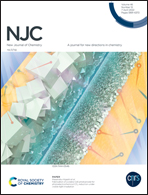Polyamidoxime grafting on ultrahigh-strength cellulose-based jute fabrics for effectively extracting uranium from seawater†
Abstract
Uranium resources in the ocean are very rich and are an ideal substitute for the increasingly depleting terrestrial uranium mines. Hence, it is an urgent need to develop adsorbents that simultaneously possess robustness, high extractive efficiency, and eco-friendly nature to capture uranium from seawater. Herein, a polyamidoxime (PAO)-grafted cellulose-based jute fabric (Jute–TMC–PAO) was developed via an etching–grafting–hydrolytic process. A homogeneous PAO layer was grafted onto an alkali-treated jute fabric surface via covalent bonding with trimesoyl chloride (TMC) as a bridging agent, followed by the generation of carboxyl groups by hydrolysis. The resulting Jute–TMC–PAO demonstrated an ultrahigh tensile strength of 376 MPa, providing a highly efficient adsorption rate of 0.233 mg g−1 day−1 in simulated natural seawater. Importantly, the structural integrity of Jute–TMC–PAO was well–reserved and the tensile strength loss was no more than 5% after a long service practice. Moreover, the readily available cellulose-based jute in Jute–TMC–PAO exemplifies its eco-friendly advantage. Therefore, Jute–TMC–PAO is a promising engineering candidate for harvesting uranium from seawater owing to its robustness, efficiency and environmentally sound characteristics.



 Please wait while we load your content...
Please wait while we load your content...